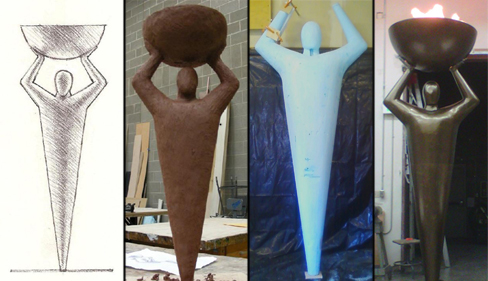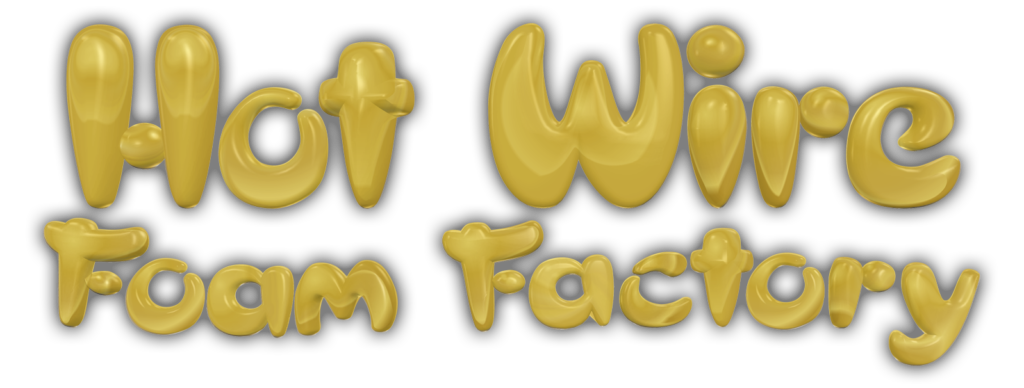Spotlight On: Andy Tirado
Andy Tirado is the owner and operator of Artworks, a custom prop fabrication shop in Colorado. Artworks specializes in any kind of prop or display for trade shows, museums, zoos, films and live events.
Hot Wire Foam Factory: What led you to start working with foam? What was your first project?
Andy Tirado: The intended use of each project – the who, what, where, when, and why – determines the best materials and approach – determines the “how???. Foam is a cool material in a lot of ways. It’s lightweight, so you can make some really large things and not have your back go out on you. It’s easy to carve. It’s quick. It’s relatively inexpensive. Did I mention it’s lightweight? Depending on the type, density, and how you surface it, foam can be incredibly durable and long lasting.
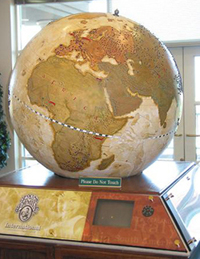 The first project where I used foam extensively was building a 4’ diameter old world globe for a welcome center. The client wanted to be able to easily stick pins in it, like a giant pincushion – a pincushion whose axis tilts with respect to the plane of its orbit around the sun at an angle of 23.4 degrees. Anyway, I fiberglassed an exercise ball, cut the fiberglass shell in two hemispheres, and filled each half with a steel axis/foam supporting frame and a two-part expandable foam. Once the foam had cured sufficiently, I cut it cleanly at the equator line and epoxied the two halves together. Then, primer, paint, and install. Viola – only it took significantly more than six days and a rest for me.
The first project where I used foam extensively was building a 4’ diameter old world globe for a welcome center. The client wanted to be able to easily stick pins in it, like a giant pincushion – a pincushion whose axis tilts with respect to the plane of its orbit around the sun at an angle of 23.4 degrees. Anyway, I fiberglassed an exercise ball, cut the fiberglass shell in two hemispheres, and filled each half with a steel axis/foam supporting frame and a two-part expandable foam. Once the foam had cured sufficiently, I cut it cleanly at the equator line and epoxied the two halves together. Then, primer, paint, and install. Viola – only it took significantly more than six days and a rest for me.
In the last few years, we’ve been working with expanded polystyrene, or EPS foam, which again has lots of qualities that makes it the perfect material for a lot of the custom projects Artworks does.
HWFF: Do you find that using foam allows what you want to accomplish faster?
AT: No doubt, which means we can say yes to clients more often. And because of foam’s expediency, which means less costly labor, we hear “yes” more often from clients as well. And we like that.
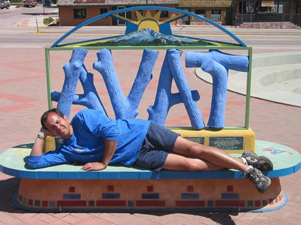
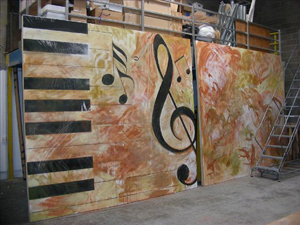
HWFF: How have the Hot Wire Foam Factory tools affected your artwork?
AT: Whenever you use any new tool for the first time there’s an “aha??? moment where you realize a whole new landscape of possibilities for creating things has opened to you. Using your hot knife and bow saw tools were definitely like that. They allow you to do things that would be virtually impossible, or very costly, otherwise. Likewise, your Foam Coat coating is easy to use and makes a very durable, hard shell.
HWFF: Which tool is your favorite and why?
AT: Oh, probably the Industrial Hot Knife, just because of its versatility and the speed with which it can shape a block of foam.
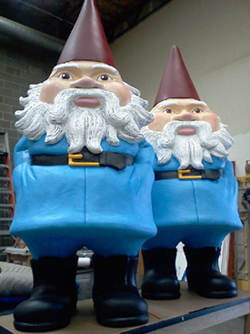 HWFF: Do you have a “crown jewel??? or favorite piece of artwork you’ve done?
HWFF: Do you have a “crown jewel??? or favorite piece of artwork you’ve done?
AT: Well, if we’re talking foam, the 7’ tall gnomes were a blast. Makes me feel sorry for people whose work doesn’t elicit the kind of responses from people that the work we do does at times. I mean the kind of responses where people do double takes and smile and virtual strangers walk up and want to find out what the heck you’re doing.
HWFF: Any other exciting projects coming up in the future?
AT: We’re currently working on some large 3D food items – carrot, apple, pear, cheese, crackers, etc., for a food and beverage company whose name you’d recognize. Talk about supersized – these definitely are. They’re components for a trade show booth. I often coin projects with an in-house name. I’ve coined this one “Voluminous Vittles”.
HWFF: When and where did you start the pursuit of art?
AT: Neither of my parents were artistic in the visual sense, and I don’t remember ever going to an art museum or looking at art until high school, but all three of my siblings and I are creative and all three of us males are involved in art making today (since we can’t make money like our sister does, with her beauty and acting ability). I was the prototypical class artist throughout school, which basically means I was the one who was asked to paint lettering on the banners. In high school my art teacher, Floyd Tunson, a charismatic and gifted artist, was the one who first encouraged and inspired me to spend most of my time in the art studio, where I could often be found with a thick dollop of paint on a brush in my left hand and a thick art history tome in the other, trying to emulate the brush strokes of certain artists I found therein.
In college, after briefly entertaining the idea of going into journalism but again finding myself magnetically drawn to the school’s art studio, I switched majors to studio art, jumped around a bit from school to school and state to state, and in my junior year was presented with the opportunity to work as an assistant for an artist I had admired since high school, the painter Chuck Close, in New York. A few months before, Chuck had become a quadriplegic due to a collapsed spinal artery and was in need of an assistant when he moved back to the city after a summer of recuperating at the Closes’ home in Bridgehampton. It’s a longer story than I can relate here, but it was an incredible thing to find myself, at the age of 19, plucked from the Midwest and dropped into the very epicenter of the New York art scene. During my time there, Chuck graciously allowed me to paint in his studio, yet though I was in what could only be described as the perfect place for a young artist to be – being an artist’s assistant and more to the point that artist’s assistant is the perfect entre for one with my aspirations and goals – I found myself highly disillusioned with what I was creating, or more to the point why I was creating what I was creating, and began to think about giving up making art altogether.
One day I found a book at the Strand Book Store that showed how to build wood strip canoes. Though I didn’t buy it, a few weeks later the thought popped into my head that that’s what I wanted to do, and I searched in vain for the book. Although I had no interest in canoeing or canoes themselves, I thought it would be a way to make something beautiful which didn’t need to mean anything other than what it was: a boat. The girl I was dating at the time, who later became my wife, found a great book on building wood strip canoes called Canoecraft at a second-hand book store in Colorado Springs and sent it to me. Again Chuck generously allowed me to take up a sizable portion of his studio in Bridgehampton and I began to build a 16’ long canoe, buying and learning how to use the requisite woodworking tools and machines.
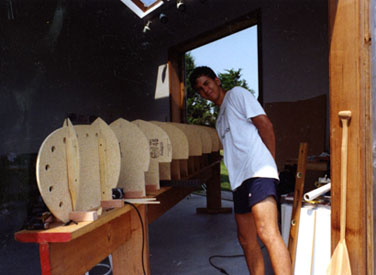
Fast forward to the mid 90’s: now back in Colorado, married, and as a “Mr. Mom??? (househusband) for a growing family, I worked on and off for a set builder, working on sets for commercials and videos, and learning how to use a few more tools. Then, in 1998, my wife Nan and I switched roles and I started Artworks.
HWFF: Do you have a word or words of encouragement for an up-and-coming artist?
AT: Yes, though it’ll sound like discouragement. I heard a statistic when I was at the School of the Art Institute of Chicago that ten years later, only 10% of Masters in Fine Art grads are still making art even as a hobby. 1 in 10. I don’t know what the stats are for someone without a MFA degree, with just a bachelor’s degree in art, but they must be even worse – 1 in 15? 1 in 20? What about those who never finished their bachelor’s? 1 in 50? 1 in 100? I never finished my undergraduate degree, and yet somehow I’ve been able to put enough food on the table to feed a family of seven. My wife’s stayed at home for the past thirteen years and counting. I just have to rob a bank every few months. Just kidding.
Here’s my encouragement: If you love doing it, keep at it. Only, don’t wait until inspiration strikes you. The ones who make it, and continue to make it, are those who continue to make it; those who keep putting one foot in front of the other, day after day. Those who wait until the muse touches them don’t realize the muse only touches those who are actively engaged in the act of creating.
